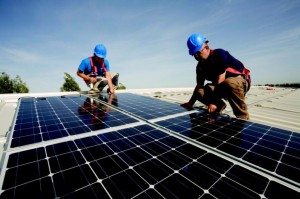By Sydney Shaw
Opinions Editor
A couple from Ohio may have discovered a way to deal with our warming Earth and the toll that humans are taking on the planet. Scott and Julie Brusaw hope to use America’s highway system to capture and convert the power of the sun.

Unless you live under a rock, I’m guessing you’ve heard of Solar Roadways Incorporated. The YouTube video “Solar FREAKIN’ Roadways!” went viral this summer, garnering over 18 million hits so far.
The idea is exactly what it sounds like — roads made from solar panels. Although the project is gaining publicity now — especially in the past few weeks in venues like BBC News and Dish Magazine — the couple has been working on it for years.
“Years ago, when the phrase ‘global warming’ began gaining popularity, we started batting around the idea of replacing asphalt and concrete surfaces with solar panels that could be driven upon,” according to the website, SolarRoadways.com. “We thought of the ‘black box’ on airplanes: We didn’t know what material that black box was made of, but it seemed to be able to protect sensitive electronics from the worst of airline crashes.”
In 2009, the Brusaws received a contract from the Federal Highway Administration to build a prototype. After successful completion of Phase I, the FHA awarded them with a $750,000 contract for Phase II.
Scott even presented the Solar Roadway at a TEDx Talk in Sacramento on April 16, 2010, calling it “the talk of (his) life.”
If implemented, the Solar Roadways Project will generate three times more clean energy than needed and will cut carbon emissions by 75 percent.
It is an interesting idea, but is it a feasible one? I say yes, but not right now.
Before undertaking such a massive project, we must think about the cost of ripping up every paved road in the nation and laying down solar panels. Each panel costs about $7,000 and the plan calls for billions of them. It would take several years before the electricity generated would recoup their own costs.
Then there’s the question of how the panels would work on cloudy days. As is, most solar panels convert only about 14 percent of available energy into electricity. Would these panels be worth it to parts of the country that must endure long winters and cloudy seasons? Even right here in New Jersey, the College endured days straight of rainy weather last week.
Would glass panels withstand the harsh punishment from cars, trucks and other heavy vehicles? There is a chance that they would shatter under the weight.
There are many questions, but one thing is for certain — this country cannot depend on fossil fuels forever. We are destroying our planet. There has to be another solution.
However, solar panels need to be developed further before they are laid across every major roadway in America.
We have certainly come a long way since the first Solar Collector built by Swiss scientist Horace-Benedict de Saussure in 1767, but there is still a ways to go. The efficiency of individual panels need to be high enough to justify spending billions, or even trillions, of dollars on their installation.
If there is more preparation put into the Solar Panel Roadways project, it can be a tremendous success in the near future.






